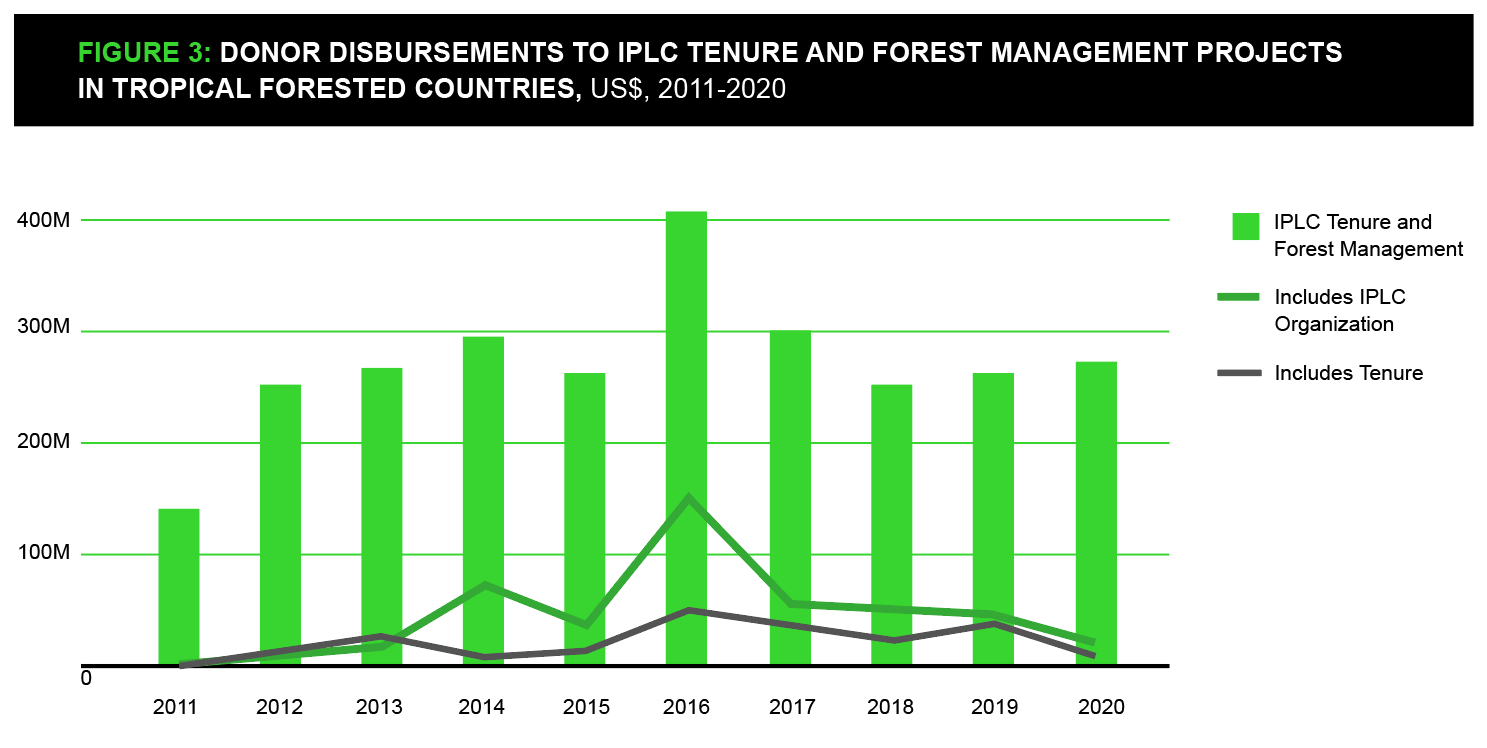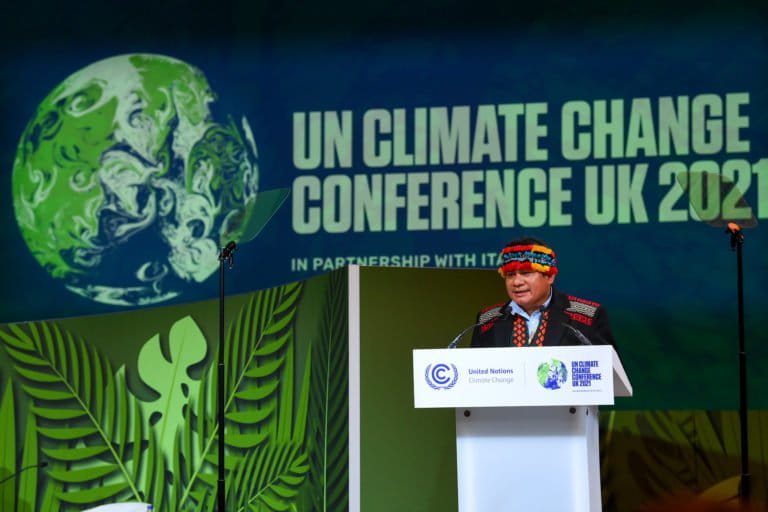- The lead author of a Rainforest Foundation Norway report showing how little funding goes to Indigenous peoples and local communities (IPLCs) for tenure and forest management writes that the reality is even worse than the “less than 1%” soundbite often shared.
- Over 10 years, $2.7 billion was given to support IPLCs’ tenure rights and forest management, which equals 0.74% of total development aid allocated to address climate change.
- Researchers further discovered that 17% of the funding to IPLC tenure and management went to projects that specifically included an IPLC organization, thus representing 0.13% of aid designated to climate change.
- This post is a commentary. The views expressed are those of the author, not necessarily Mongabay.
Indigenous peoples and local communities (IPLCs) received an unprecedented level of attention, recognition and support at this year’s United Nations climate summit, known as COP26. This was the result of many years of consistent and strategic campaigning by IPLC groups and their allies, in combination with growing scientific evidence that shows how their custodianship of land and forests is an indispensable solution to climate change.
In just about any panel or session I attended at COP26, one would hear the same soundbite: “Indigenous peoples receive less than 1% of climate finance.”
This is not wrong, but as one of the policy advisers responsible for digging up this number, I feel like I have a responsibility to point of that the reality is actually far worse. It is well below 1%.
The number comes from a report Rainforest Foundation Norway (RFN) published in April this year, with the help of two relentless number crunchers at Indufor North America, Jeffrey Hatcher and Michael Owen. This report maps the international funding that went to support IPLC tenure rights and forest management, from bilateral, multilateral and philanthropic donors. The figure we found was $2.7 billion over the last 10 years.

When we compared this to all climate aid (counted as official development aid, or ODA) over the same period, we found that this was less than 1% — hence the soundbite. Actually, the figure is 0.74% of climate ODA. This figure was rounded up to account for uncertainties on both sides of the equation.
In the report, RFN chose the precise, but not so campaign-friendly, formulation: “[Support for] IPLC tenure and forest management amounted to less than the equivalent one percent of ODA for climate.”
The reason for choosing this complicated wording was due to the fact that funding for IPLC tenure and forest management comes from several of the donors’ thematic priorities: climate change, biodiversity, agriculture, livelihoods, human rights, etc.
As such, the comparison with climate finance was to indicate its scale, or lack thereof. The 0.74% figure is in fact not a share of climate finance, but how the total IPLC tenure and forest management funding compared to the total scale of climate ODA. Climate finance is likely to dominate but not make up all of the funding for IPLC tenure and forest management. And ODA only makes up a part of what is usually counted as climate finance toward the $100 billion target.
Funding in the hands of intermediaries
Further, the $2.7 billion delivered over 10 years is not a figure that actually went to IPLCs and their organizations, as one might think from hearing the soundbite. It includes funding for government institutions or other implementing organizations to implement tenure reforms or programs that improve forest monitoring, land use management, and livelihoods in and around Indigenous forests, etc.
All of this can, and hopefully will, have a positive impact on IPLC’s rights and ability to live in and off their traditional forests, but it is not funding to IPLC organizations.

Further, we found that most of the funding goes to or through multilateral institutions or large international organizations. The research was done by searching through publicly available databases on aid disbursements for relevant disbursements. These databases represent a major improvement on aid transparency, but unfortunately don’t yet allow us to track funding disbursements all the way to IPLC organizations.
The current funding architecture of IPLC support largely relies on one or several other organizations or institutions to act as intermediaries between the donor and the IPLC organizations — organizations such as RFN. And in the databases, only the first recipient in this chain of granting and regranting is reported, so it’s impossible to assess how much ends up in the hands of IPLC organizations.
However, researchers at Indufor searched the descriptions of the projects that made up the $270 million per year figure to look for specific mentions of IPLC organizations from across the tropics. They found that only about 17% of the funding went to projects that mentioned an IPLC organization.
This constitutes no more than $46 million per year. Or, in other words, 0.13% when compared to all climate development aid. This is an indication of how much, or should we say how little, of the total funding reaches these organizations.
When we say “indication,” it rests on two caveats. First, not all of this funding is likely to reach IPLC organizations, as the intermediaries involved also have overhead costs. Second, we cannot rule out that IPLC organizations may receive funding through projects that don’t specify the name of the organization in their project description. However, it’s unlikely that much of this funding will be passed on to IPLC organizations, beyond the identified 17%.
This assumption is strengthened due to the fact that most of the funding we identified went to either large international organizations or to multilateral institutions, such as the World Bank, the regional development banks, or the U.N. Anecdotal evidence shows that not much of the funding that goes through these institutions ends up in the hands of the IPLC organizations.

Any successful campaign depends on having a clear, catchy message that is easy to repeat and remember, for both the campaigners and their targets. “Indigenous peoples receive less than 1% of climate finance” became such a successful message before and during COP26 — with potentially major impact on how funding for tropical forests protection is spent.
However, as our research shows, the reality of the matter is even worse. This makes the demand of the Indigenous leaders for more and more direct funding, which was reflected in the $1.7 billion IPLC forest tenure pledge at COP26, even more important and urgent. Now, with the research we’ve done, we have the tools needed to monitor whether this pledge materializes.
Torbjørn Gjefsen is a climate policy adviser at Rainforest Foundation Norway (RFN). He has led RFN’s work on the “Falling Short” report that helped build the case for more funding for IPLCs as part of the climate and nature protection and restoration agendas.
Banner image: The Waorani community protesting and campaigning for other indigenous Amazon communities. Photo by Kimberley Brown for Mongabay.
Related listening from Mongabay’s podcast: A conversation with Victoria Tauli-Corpuz and Zack Romo about Indigenous rights and the future of biodiversity conservation. Listen here:
FEEDBACK: Use this form to send a message to the author of this post. If you want to post a public comment, you can do that at the bottom of the page.
